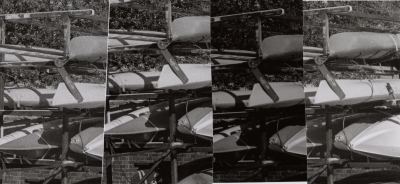
To compare these developers, I shot a roll of film in harsh sunlight. I used less exposure than I normally would have, since I wanted to evaluate shadow speed. I developed pieces of the film in all the developers I have using all the times I usually use. I wanted to see how the contrast varied so that I could fine-tune my development time for each developer, plus I wanted to compare the graininess, since I had noticed HC110 was grainier than D23. After developing them in a 20C water bath with 3 inversions per minute, I printed them using the same enlarger times using a grade 2 filter. I found that the D23 was much slower than the other two, so I printed an additional frame for less time so that I could fairly compare the tonality and grain. I scanned all the prints side-by-side using my basic scanner software and no processing, at 800DPI to capture the grain. Click for the monstrous full-size version.
Film:TMY1, expired
Exposure: Texas sunlight, 1/500 at f/11.
Developers left to right:Rodinal 50:1 9min, HC110 50:1 9 min, D23 8 min, D23 8 min
Printing times L-R: 20s, 20s, 20s, 10s
First of all, Rodinal is the most grainy, clearly, but it's worth noting that the image area shown is less than a 110 frame. It represents about a 2x3 inch piece of an 11x14 print. HC110 was similar in graininess to the Rodinal, and D23 was much less grainy than either. However, the D23 was much slower. The difference looking at the negatives was subtle, the different looking at the 35mm contact prints was noticeable, and the difference when printing them at the same time was obvious. I really didn't know I was losing so much speed with D23, and it's making me wonder if I mixed it up right. I do like that it has very low graininess, yet retains detail well. I don't really see a loss of resolution with the D23 due to the solvent action, if anything it seems a bit better than the 'normal' developers. But I'll have to remember that since D23 is rather soft-working, in any underexposure scenario, I'd better reach for a different developer.